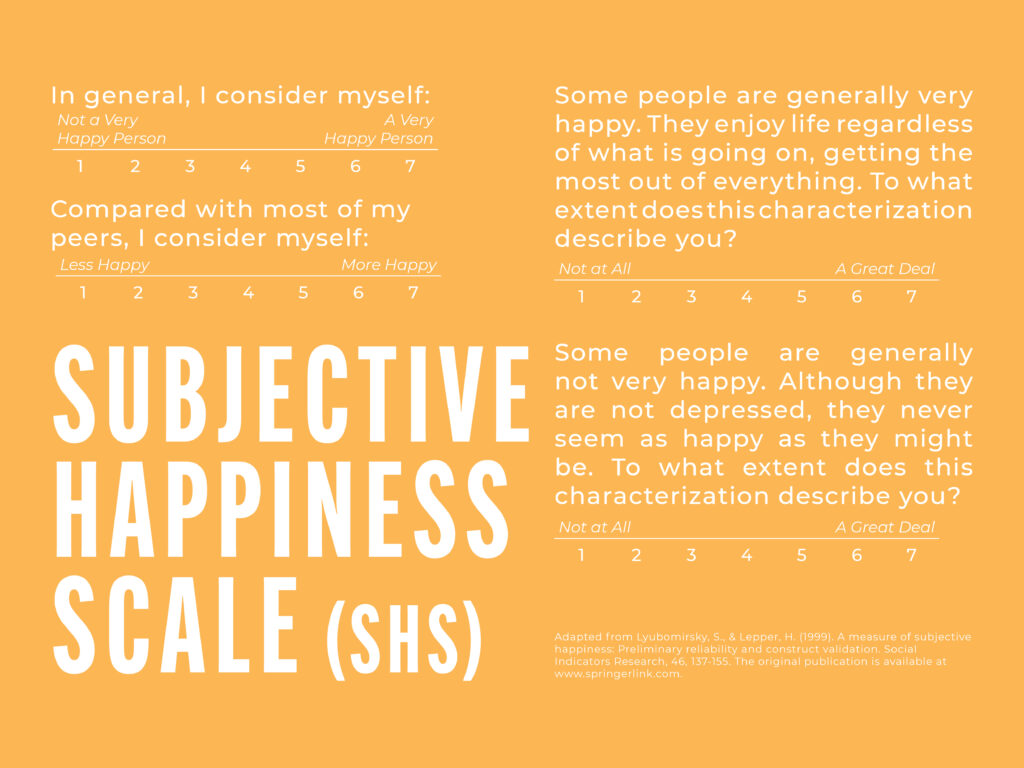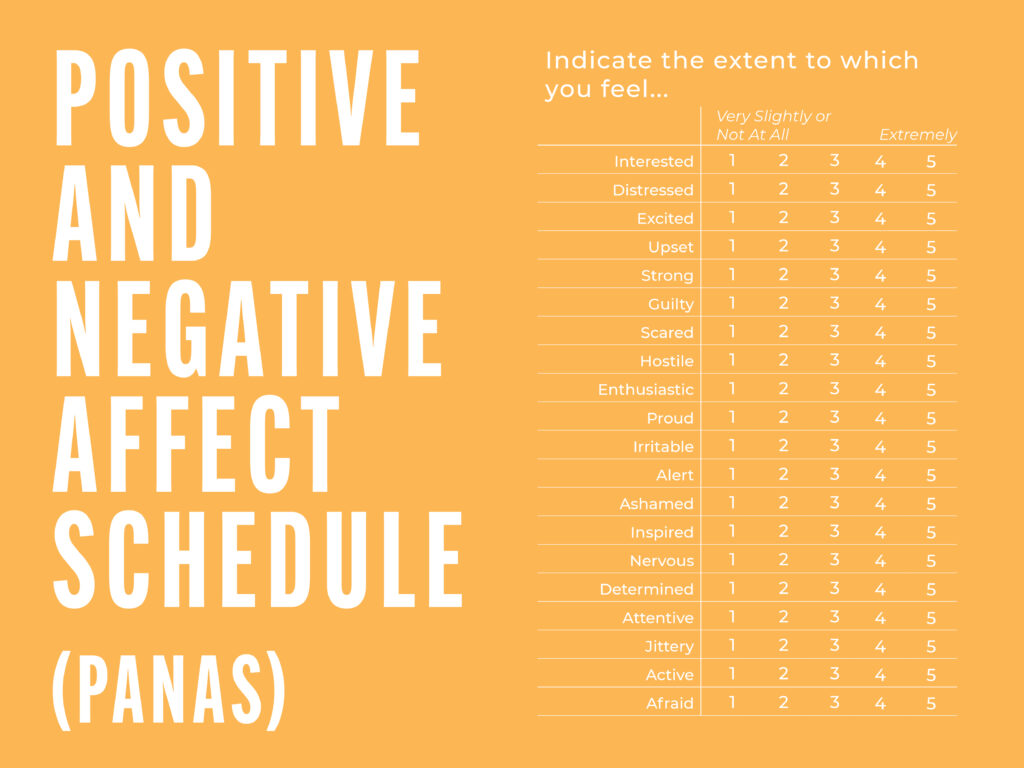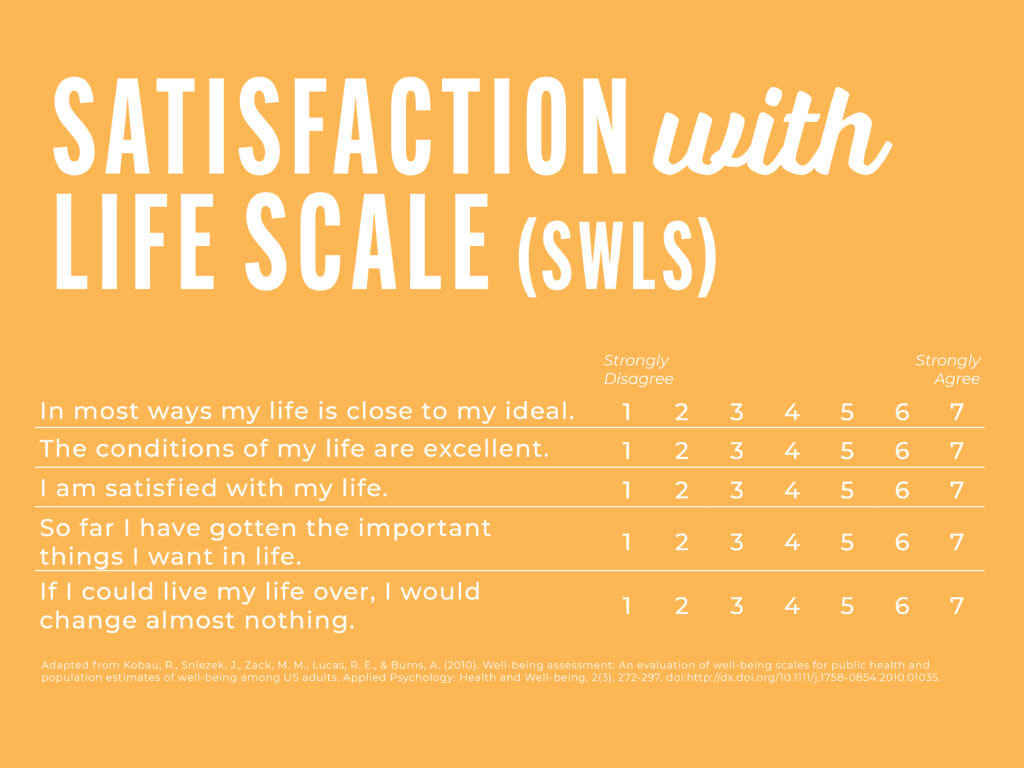Last month, we talked about defining happiness. Among a handful of definitions, we pulled Dr. Sonja Lyubomirsky’s definition out as the best.
Happiness refers to “the experience of joy, contentment, or positive well-being, combined with a sense that one’s life is good, meaningful, and worthwhile.”
Dr. Sonja Lyubomirsky
The strength and appeal of Dr. Lyubomirsky’s definition, beyond its simple clarity, is in how it captures both facets of happiness: hedonic happiness and eudaimonic happiness (for a refresher on terminology, refer to the recent post, “Defining the ‘what’ of happiness“).
The Subjectivity of Happiness
Whether equating it with pleasurable experiences or with life satisfaction, happiness is highly personal.
Indeed, the subjectivity of happiness makes it difficult to weigh and compare. Some scientists have explored the use of hormone levels as a more precise and quantifiable measure, or utilizing observed behavior as a method to measure happiness in others. Of course, many would prefer an objective, tangible metric…which would be great…if such a metric existed. Unfortunately, it’s not that simple.
Take, for instance, Jeremy Bentham’s calculus. According to Bentham, the measure of happiness is just the sum of pleasure minus pain (Montgomery, 2014, p. 23). Easy enough, right? Unfortunately, even Bentham had difficulty applying this utilitarian approach. Concepts like pain, pleasure, and happiness are both subjective and also relative. What it means to thrive varies from culture to culture, and even from person to person.
Challenges aside, measuring happiness is important because it allows us to track, compare, establish goals, and benchmark our progress toward happier communities. Additionally, we are more likely to pay attention to that which we measure—which is to say, measuring happiness will lead us to prioritize happiness.
Fortunately, the data doesn’t have to be perfect in order to be useful.
Subjective Well-Being
Both hedonic and eudaimonic happiness are evaluated in the annual World Happiness Report (WHR), which tracks three measures: cognitive life evaluations and emotional reports (either positive affect or negative affect, each measured separately) (p. 11 WHR, 20212). The report authors acknowledge that happiness is an evocative word and a rather general expression that sometimes creates confusion (Helliwell et al., 2012). This is perhaps why scientists prefer the term, “subjective well-being,” or SWB. In scientific studies, SWB can function as an indicator of happiness as expressed through individual self-reports of mood (hedonic happiness) and life assessment (eudaimonic happiness).
Although “subjective well-being” sounds a bit too clinical or academic (both of which are qualities that can be off-putting for some), SWB as a self-reported indicator means that was can actually measure and assess happiness, and it means that the power of evaluating our happiness as individuals and our contentment with our lives is entirely within our own hands.
I am the expert on me.
Are subjective surveys accurate? In fact, they are. Studies have confirmed people’s accuracy in self-reporting their mood by measuring and cross-comparing cortisol levels in their blood tests (Montgomery, pp. 30-31). So as it happens, if you want to know if someone’s happy, you can just ask.
Subjective Methods for Measuring Happiness
There are a few methods used for collecting self-reported measures of happiness, and some of the most well-known and reliable methods discussed here.
Subjective Happiness Scale (SHS)
In 1999, Dr. Lyubomirsky, with her colleague Heidi Lepper, published a white paper detailing the reliability of their new four-question Subjective Happiness Scale (SHS). The simplicity of this short survey, which asks individuals about the extent to which they believe they are a happy person and living a happy life, is intended to be as non-threatening as possible to the participant.

Positive and Negative Affect Schedule (PANAS)
Developed in 1988 by researchers from the University of Minnesota and Southern Methodist University, the Positive and Negative Affect Schedule (PANAS) is a self-reported questionnaire that consists of two 10-item scales to measure both positive and negative affect. Using a five-point Likert scale, participants report the extent to which they feel a relationship to each of the 20 items.

Satisfaction with Life Scale (SWLS)
Using a seven-point scale, the Satisfaction with Life Scale (SWLS)—created by Ed Diener, Robert A. Emmons, Randy J. Larsen, and Sharon Griffin in 1985—asks participants to indicate the degree to which they agree or disagree with each of five statements pertaining to their life satisfaction.

Cantril Ladder Method
The Cantril Ladder, also known as Cantril’s Self-Anchoring Ladder of Life Satisfaction, was developed in 1965 and is another self-reported measure. Used in the Gallup World Poll, this method asks respondents to think of a ladder, with their best possible life being a 10, and the worst possible life being a 0. They are then asked to rate their own current lives on that 0 to 10 scale. Participants are also asked to imagine their life in the best possible light and to describe their hopes and wishes for the future.

Towards a Universal Measure of Well-Being
Additional methods have begun to consider a means to evaluate well-being at the larger scale of entire communities or nations. Many of these methods present an alternative to the Gross Domestic Product (GDP), a leading tool for measuring the economic strength of a country since 1944. The Positive Psychology Center out of the University of Pennsylvania notes, however, that there has been increasing awareness “that economic measures alone do not fully reflect a nation’s progress and well-being.”
New qualitative methods for evaluating happiness challenge the GDP and present alternative indices, which their creators believe are more appropriate measures of national well-being. While the following indices do not evaluate happiness exclusively, they consider happiness a component, often using the same subjective methods noted above.
Gross National Happiness (GNH)
Developed in 2012 by the Bhutan Government, and one of the most well-known instances of measuring well-being at a national scale, the GNH index was created to evaluate the collective well-being of Bhutan. Its approach is more holistic than the standard Gross Domestic Product and relies on a complex survey (consisting of nine domains, 33 indicators, and hundreds of variables) that incorporates Buddhist principles.
Gross National Wellness/Well-Being (GNW) Index
Before there was the religious and culturally-oriented GNH in Bhutan, there was the Gross National Well-being concept. In 1972, the European Commissioner for Agriculture, Sicco Mansholt, advocated for an alternative metric to the Gross Domestic Product, suggesting that the ideal purpose of a government is to promote happiness. The Gross National Wellness (GNW) Index was later created in 2005 by Med Jones, an American economist, as a socioeconomic measurement incorporating both a qualitative and quantitative framework. The GNW Index consists of seven dimensions: economic, environmental, physical, mental, work, social, and political. Unlike Bhutan’s GNH, this index is scientific and secular.
Happy Planet Index (HPI)
The Happy Planet Index (HPI) measures human well-being and environmental impact. It was introduced by the New Economics Foundation in 2006. The HPI of a country is measured as a function of the average subjective life satisfaction, life expectancy at birth, and ecological footprint per capita. This formula allows the index to consider resource use and sustainability. Placing further emphasis on the importance of ecological impacts, the index is weighted to give higher scores to nations with lower ecological footprints.
Social Progress Index (SPI)
First introduced in 2013, the Social Progress Index (SPI) seeks to better measure a country’s development and priorities. Like the HPI, the SPI also considers environmental performance, tracking 54 indicators related to basic human needs, well-being, and opportunity to measure how well countries provide for the social and environmental needs of their citizens.
OECD Better Life Index
Following a decade of work on the subject of better-evaluating society, the Better Life Index was created in May 2011 by the Organisation for Economic Co-operation and Development (OECD). It attempts to pull internationally comparable measures of well-being, looking at 24 indicators within 11 topics.
Measuring Happiness Matters
“Not everything that counts can be counted. Not everything that can be counted counts.”
Unknown
Countries have for many years turned to economic measures to determine the strength of their nation—painting what is increasingly recognized as an incomplete picture and devaluing many other measures that more significantly influence quality of life of citizens. Studies show that our behavior is affected by our attention. Therefore, when we choose to measure values like happiness and well-being, our decisions will be driven to promote happiness and well-being.
As communities and nations, when we measure what matters, we are better equipped to make decisions that are truly aligned with our values.
Resources
Ackerman, C. E. (2020, January 1). What Is Happiness And Why Is It Important? Positive Psychology. https://positivepsychology.com/what-is-happiness/
Happiness.(n.d.) In Merriam-Webster’s collegiate dictionary. http://www.merriam-webster.com/dictionary/happiness
Helliwell, J. F., Layard, R., & Sachs, J. (Eds.). (2012). World Happiness Report. New York: Earth Institute.
Lyubomirsky, S. (2007). The How of Happiness: A New Approach to Getting the Life You Want. Penguin Books.
Mogilner, C., Aaker, J., & Kamvar, S. D. (2012). How Happiness Affects Choice. Journal of Consumer Research, 39(2), 429–443. https://doi.org/10.1086/663774
Montgomery, C. (2014). Happy City: Transforming Our Lives Through Urban Design. Farrar, Straus and Giroux.
What is Happiness. (n.d.). The Greater Good Science Center. Retrieved September 29, 2020, from https://greatergood.berkeley.edu/topic/happiness/definition

